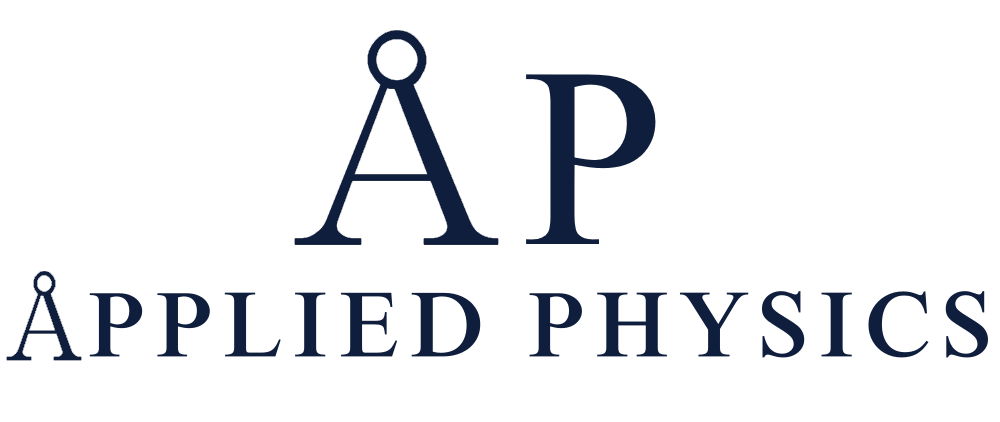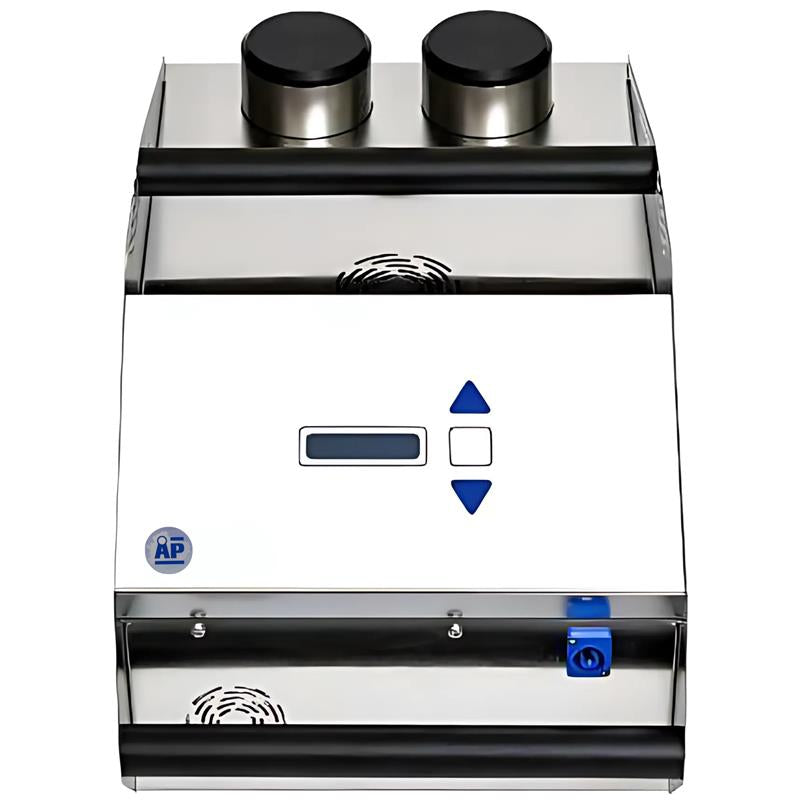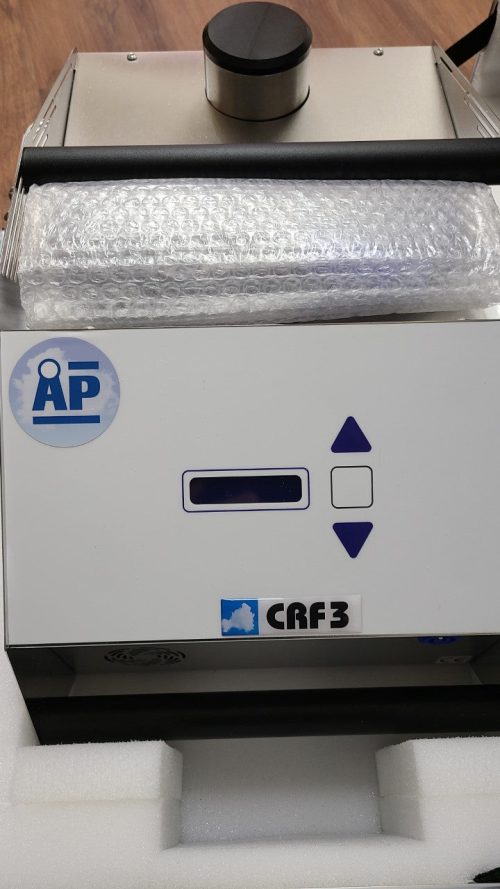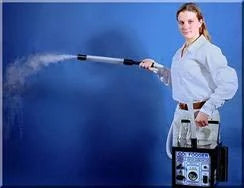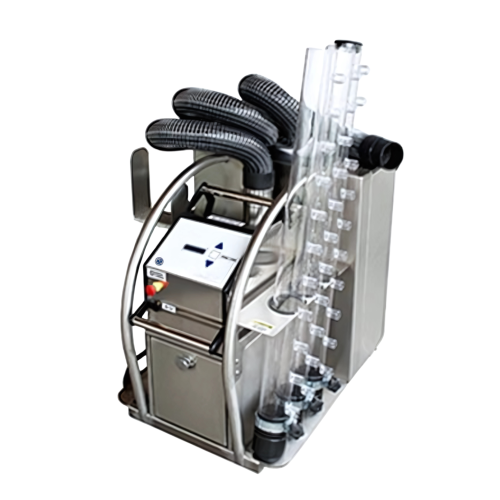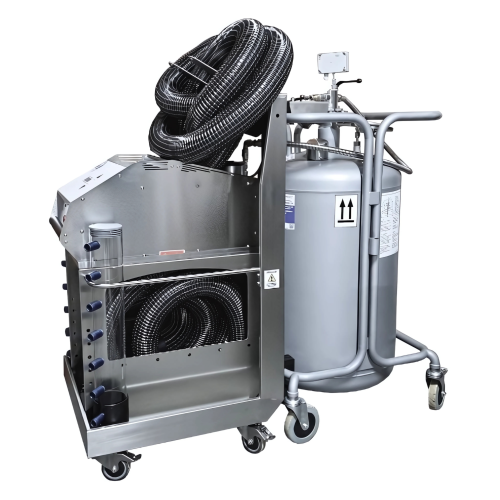[annasta_filters preset_id=1]
CRF6 Clean Room Fogger with dual 80mm Fog Outlets
CRF6 Cleanroom Fogger with 40 Piezos, 2.0 Cubic Meters fog per minute with Dual 80mm fog outlets; Stainless Steel design & enclosure, Touch Pad control
The CRF6 is an advanced, portable clean ro…
| Title | Range | Discount |
|---|---|---|
| Quanitity Discount | 3 + | 10% |
CRF6 Cleanroom Fogger with 40 Piezos, 2.0 Cubic Meters fog per minute with Dual 80mm fog outlets; Stainless Steel design & enclosure, Touch Pad control
The CRF6 is an advanced, portable clean room fogger with a stainless steel enclosure and dual, 80mm fog outlets to get more fog output in a shorter time for your smoke study. It uses deionized (DI) water, sterile water and water for injection (WFI) to generate 2.0 cubic meters of pure fog per minute for about 45 minutes at 213 ml fog density per minute to provide from 12 to 15 feet visible fog distance using a dual fog output. Compare other foggers to the CRF6 by verifying fog volume output? How much fog density does the competitive fogger provide? Can it be controlled directly and remotely with a wireless control? Does it have common sense accessories for your smoke studies? The CRF6 provides all these needs and supports smoke studies in BSCs, RABs, Barrier isolators, glove boxes and medium sized clean rooms.
CRF6 Cleanroom Fogger for use in Bio-Safety Cabinets, RAB, Barrier Isolator and Cleanrooms
CRF6 Portable Cleanroom Fogger, Smoke Studies in Clean Rooms, Sterile Rooms, BSC, Barrier Isolators, and ISO Suites
Cleanroom Fogger Performance Comparisons
CRF6 Portable Fogger for Smoke Study guided by ISO 14644-3, FDA Compliance and USP 797, Dual 80mm fog outlets and Adjustable Fog Control
USP797, FDA, ISO 14644-1 and 14644-2 airflow guidelines
The CRF6 is ideal to visualize airflow in pressurized clean areas, such as glove boxes and barrier isolators. The CRF6 can be operated by remote control or direct touch pad control, and because the CRF6 is relatively compact in size, it can be inserted inside or beside a glove box, RAB or barrier isolator, allowing the dual fog outlets to provide fog to two inputs of your smoke study, while allowing the fog flow velocity to be adjusted directly or by wireless remote. The CRF6 is designed to tune the dual fog output to your airflow dynamics, providing up to 12 to 15 feet visible airflow. The CRF6 Cleanroom Fogger is primarily used in pharmaceutical clean rooms, ISO suites, sterile rooms, bio-safety cabinets, RABs and medical rooms. Airflow guidelines ISO 14644-3, USP 797, Federal Standards 209E and its replacement ISO Standard 14644-1 and 14644-2 are supported for airflow recovery tests.
Smoke Study, CRF6
Applied Physics provides clean room foggers to visualize airflow turbulence, patterns, velocity, and dead zones during smoke studies. The CRF6 uses only DI water, WFI or Steril Water and produces as much pure fog as the small ultrapure foggers using LN2 and DI Water. The CRF6 includes adjustable airflow velocity, adjustable fog volume and wireless remote control, which is not found on competitive ultrapure foggers. So the CRF6 costs about the same as the smaller LN2 smoke machines, but provides more fog output than the original LN2 foggers. It is much easier to set up and operate, and offers many more accessories to support your various smoke study requirements.
The advantage of the CRF6 is the fog density generated at 213 ml per minute, which is higher than any other smoke machines in the world. When you look at the different smoke generators available, it is important to determine how much fog volume the fogger produces? How much fog density is generates? And the typical visual distance of the fog in typical sterile room operation. All foggers provided some form of direct control of the fog, but does your smoke generator offer wireless remote control of the fog operation, so that it can be used inside a closed area.
Watch CRF4 Fogger Video. The CRF6 is similar to the CRF4, see video at left. The CRF6 is the smoke generator to select when you want higher volumes of fog, dual fog output, adjustable fog controls, but do not want to use liquid nitrogen in your smoke study. It is the fog density and fog volume that generates visual fog distance. Most fog generators are described without referring to fog volume, fog density and visual airflow distances, showing marketing pictures of the smoke machine without describing fog performance. If the smoke generator you may be considering does not describe its' actual fog performance, how do you know if the fog generator can meet your smoke study objectives? The CRF6 describes the fog volume, fog density and visible airflow distances, because customers buy smoke machines to achieve a desired level of air flow visualization in their smoke studies. There are a variety of accessories that can be plugged directly to the CRF6 output or attached to two 5 meter fog hoses, or just one hose.
CRF6 Clean Room Fogger
When an engineer reviews different smoke machines for their smoke studies, many suppliers of fog machines show limited technical detail. The purpose of a smoke generator is to visualize airflow, so it is important to know how much fog volume is provided by a fog generator? It is important to determine how much fog density is provided, as fog density is what enhances visual fog distance and fog volume emitted? You should know what the fog machine produces in fog volume, fog density and fog distance so that you can determine if it supports your needs. Watch CRF4 Video.
The CRF6 portable cleanroom fogger is designed with a 316L stainless steel enclosure and electrolus polish for use in all pharmaceutical and semiconductor process environments. The CRF6 Fogger emits fog through a dual 80mm fog outlets. Use both fog outlets or cap one outlet off and use one fog hose. The CRF6 Cleanroom Fogger produces as much fog as competitive LN2 foggers, which use liquid nitrogen and de-ionized water. But the CRF6 offers simple set up and operation, yet provides excellent fog volume using only de-ionized water, sterilized water or WFI water. Touch Pad Control is provided with the CRF6 as well as Wireless Remote Control; allowing direct control by the operator or remote control of the CRF6 cleanroom fogger inside a barrier isolator or closed clean room. 11 Accessories are available, such as CRF6 Carry Case, Accessory Carry Case, 5 Meter x 80mm Fog Hose, 1.3 Meter Fog Wand, Y Adaptor, T Adaptor, High Contrast LED Fog Light, 350mm Fog Nozzle, 80/50 Fog Hose Adaptor Kit with 0.6M Fog Wand, Y Adaptor with Butterfly valves, Accessory Rolling Carry Case with extending handle, wheels and lockable roll case.
Generate a Pure Fog for Clean Room, BSC, Barrier Isolator, RAB Smoke Studies
The CRF6 Ultrasonic Cleanroom Fogger supports cleanroom airflow studies to comply with FDA and USP 797 guidelines in the Pharmaceutical and semiconductor industries. This smoke generator is designed with brushed, 316L Stainless Steel outer enclosure and inner 316L stainless steel Water Chamber. The fog hoses are produced from medical grade plastic with stainless steel coil on the inside of the plastic hose wall. The Fog Hose wall itself is very tough and resistant to abuse, but flexible and pliant so the hoses can be handled, wrapped, or cut to length as needed. The black Fog Hoses are available in 80mm diameter or 50mm diameter, depending on the clean area design requirements and smoke study requirements in a BSC, Bio-Safety Cabinet, Barrier Isolator, RAB, Glove Box or Cleanroom.
The inner power supply of each fogger supports 100VAC, 110VAC and 220VAC and the power cords are specific to 100, 110 or 220 Voltage, 50/60 Hz.
The Control Interface of the fogger is a smooth plastic panel with touch pad, so there are no moving parts to operate the fogger. Power is turned on by inserting the power cable into the connector and rotating the power connector 90 degrees, which turns power on, and there is no need of a power toggle switch.
Maintenance of the fogger requires wipe down of the external surface, drain and dry of the internal water chamber and internal hoses, after fogging is completed. There is no IQ/OQ requirements, becuase the CRF6 cleanroom fogger is not used in pharmaceutical processes, but used only as a maintenance support to visualize airflow patterns and unwanted turbulence. One of the fogger accessories available is a Drain and Dry Kit, which allows the user to suck unused water out of the fogger water chamber. Then the Operator would insert the stainless steel, Air Dryer down into the fog outlet to circulate warm, dry airflow through the water chamber to evaporate all moisture before storing the fogger. The same process would be used on the fogger hoses in order that the cleanroom fogger and hoses are completely dry before storing the products.
The CRF6 smoke generator uses Deionized water, Sterile water or WFI water in clean rooms to provide a pure, non-contaminant fog that visualizes uniformity of airflow, describing turbulent locations, room to room airflow balance, etc. in support of FDA, ISO and USP 797 clean room requirements. As the fog travels into the airflow at a constant rate to visualize airflow, the fog can be adjusted in velocity and fog volume to tune thew fog output to the surrounding airflow conditions. There are a variety of fog accessories that are available to convert the stream fog output into broad displays, concentrated displays or split outputs using Y Adaptors, 80mm hoses or 50mm hoses. Transparent polycarbonate Fog Wands are available to produce wide visual fog curtains in BSCs, Barrier Isolators and in clean rooms.
As the fog exits the hose or accessory, it is constantly replenished by new fog coming out of the hose, but as the fog travels outward into the air flow, the temperature, humidity, and velocity of surrounding clean air begins to cause evaporation of the pure fog. After traveling through the clean room airflow, the fog begins to evaporate back to the same air we breathe, leaving no contamination behind. The local humidity increases in the clean area in the smoke study for a short period of time, but the exhaust fans draw the humidified air out of the clean area quickly, and the new room air then normalizes the temperature and humidity in the clean area immediately after the smoke study is completed.
The CRF6 Cleanroom Foggers provide a pure, uncontaminated visible fog to visualize the airflow patterns in support of clean room certifications for compliance to FDA and USP 797 Guidelines. The CRF6 Cleanroom Fogger permits your Metrology staff to verify uniformity of airflow, locate turbulence and dead spots and confirm room airflow balance between clean rooms, while leaving no contamination behind by the Cleanroom Fogger in the clean room and requiring no wipe down in the clean room after the smoke study is completed.
